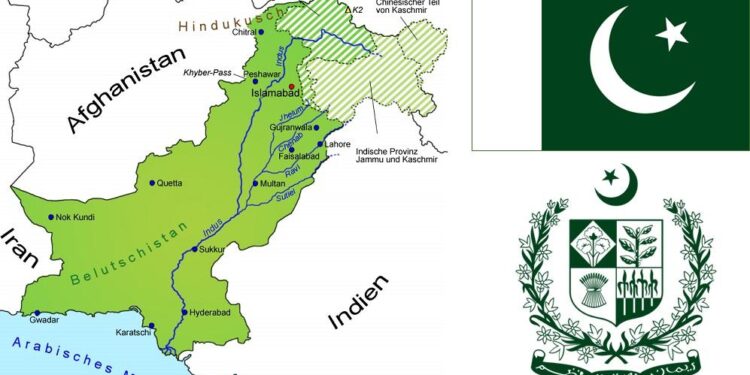As climate change intensifies and extreme weather events become more frequent, Pakistan finds itself at the precarious intersection of geography, development, and environmental challenges. The country, home to a diverse landscape that includes mountains, plains, and rivers, is increasingly susceptible to deadly flooding—a phenomenon that has claimed lives, displaced millions, and devastated livelihoods. In this article, we explore the multifaceted reasons behind Pakistan’s vulnerability to such catastrophic flooding, examining the interplay of natural factors, inadequate infrastructure, urban planning challenges, and the pressing ramifications of climate change. As the nation grapples with this ongoing crisis, understanding the underlying causes is essential for devising effective responses and building resilience for the future.
Understanding the Geographic and Climatic Factors Behind Pakistan’s Flood Vulnerability
Pakistan’s geographic location significantly contributes to its susceptibility to flooding. The country lies at the confluence of several major river systems, including the Indus River, which is vital for agriculture but also poses risks during monsoon season. When heavy rains hit, the river can swell rapidly, leading to overflow that inundates adjacent areas. Additionally, the country’s diverse topography, characterized by mountains, plains, and plateaus, magnifies the risks. For instance, the steep slopes in northern regions can trigger landslides, redirecting excessive water into villages below. The following factors further illustrate Pakistan’s vulnerability:
- Monsoon Climate: The annual monsoon leads to unpredictable and intense rainfall.
- Glacial Melt: Climate change has increased glacial melting, contributing to higher river flows.
- Deforestation: Loss of forests exacerbates soil erosion and reduces natural water absorption.
- Poor Urban Planning: Rapid urbanization with inadequate drainage systems heightens flood risks.
Examining the climatic influences, Pakistan faces a dual challenge. Seasons of extreme heat compound the effects of rainfall, causing rapid snowmelt and heavier downpours. The changing climate is also resulting in more frequent and severe weather events, making traditional flood management strategies less effective. A comparison of average rainfall and flood events over the past decade highlights a troubling trend:
| Year | Average Rainfall (mm) | Major Flood Events |
|---|---|---|
| 2015 | 800 | 1 |
| 2017 | 950 | 2 |
| 2020 | 1300 | 3 |
| 2022 | 1500 | 5 |
This data underscores the urgent need for effective policy responses to mitigate the impacts of flooding in the region. Enhanced forecasting systems, improved infrastructure, and sustainable land management practices are essential in addressing the cycle of vulnerability and disaster. Without these interventions, the risk of catastrophic flooding will only increase, posing dire threats to communities and economies alike.
Assessing the Impact of Infrastructure Deficiencies and Urban Planning on Flood Resilience
The stark realities of infrastructure deficiencies in Pakistan have exacerbated the nation’s vulnerability to flooding, a situation that is further complicated by inadequate urban planning. In many regions, outdated drainage systems and poor maintenance of waterways contribute to severe water stagnation during heavy rainfall. Additionally, rapid urbanization without effective zoning laws has led to the construction of homes and businesses in flood-prone areas. As a result, when monsoon seasons arrive, these conditions create a perfect storm, resulting in catastrophic flooding that affects thousands of lives and disrupts local economies. Key factors influencing this crisis include:
- Deteriorating infrastructure: Many cities struggle with old and poorly maintained drainage systems.
- Rapid urban growth: Overpopulation in urban areas often encroaches on natural floodplains.
- Lack of disaster preparedness: Insufficient planning and resources hinder effective response to flooding events.
Furthermore, urban planning often ignores the long-term implications of climate change on weather patterns, adding another layer of risk to flood resilience. Urban developments primarily focused on short-term economic gain neglect critical environmental assessments, which could inform more strategic placement of infrastructure. Building regulations often fail to account for geological and hydrological assessments, leading to improper construction techniques that worsen the impacts of flooding. To illustrate, recent studies have highlighted areas where a small investment in flood defense infrastructure could yield substantial returns in flood reduction, yet these measures remain underprioritized in policy discussions. A comparison of urban flood vulnerability can be summarized as follows:
| City | Flood Preparedness Rating | Infrastructure Quality |
|---|---|---|
| Karachi | Poor | Abysmal |
| Lahore | Fair | Average |
| Islamabad | Good | Relatively Strong |
Implementing Sustainable Solutions and Policy Reforms to Mitigate Future Flood Risks
The increasing frequency and intensity of floods in Pakistan underscores the urgent need to adopt sustainable solutions and implement comprehensive policy reforms. Urban planning must prioritize the integration of green infrastructure, allowing for better water absorption and drainage. Measures such as constructing retention basins, increasing green cover, and promoting rainwater harvesting can significantly mitigate flooding risks. Additionally, investing in advanced meteorological technologies will enable better forecasting, thus ensuring timely evacuations and resource mobilization in vulnerable areas.
Policy reforms should focus on enhancing community resilience through education and resource allocation. These initiatives could include:
- Strengthening local governance frameworks to support flood preparedness
- Establishing financial safety nets for affected populations
- Promoting sustainable agricultural practices that protect against soil erosion
By adopting these comprehensive strategies, Pakistan can not only address its current vulnerabilities but also pave the way for a more resilient future. A collaborative approach involving government, NGOs, and local communities is essential to foster a culture of preparedness that can withstand the impacts of climate change.
Wrapping Up
In conclusion, Pakistan’s vulnerability to devastating floods stems from a complex interplay of geographical, climatic, and infrastructural factors. The country’s reliance on monsoon rains, combined with climate change’s intensifying impacts, underscores the urgent need for comprehensive disaster management strategies and long-term resilience planning. Additionally, inadequate infrastructure and urban planning exacerbate the situation, leaving millions at risk each year. As the nation grapples with its recurring flood crises, it becomes increasingly clear that addressing these challenges is not merely an option but a necessity for safeguarding lives and fostering sustainable development. Moving forward, it is imperative for policymakers, environmentalists, and communities to collaborate effectively, harnessing both local knowledge and global expertise to mitigate the effects of future floods and build a more resilient Pakistan.














Italy to Deport Egyptian Imam After Controversial Comments at Pro-Palestine Rally